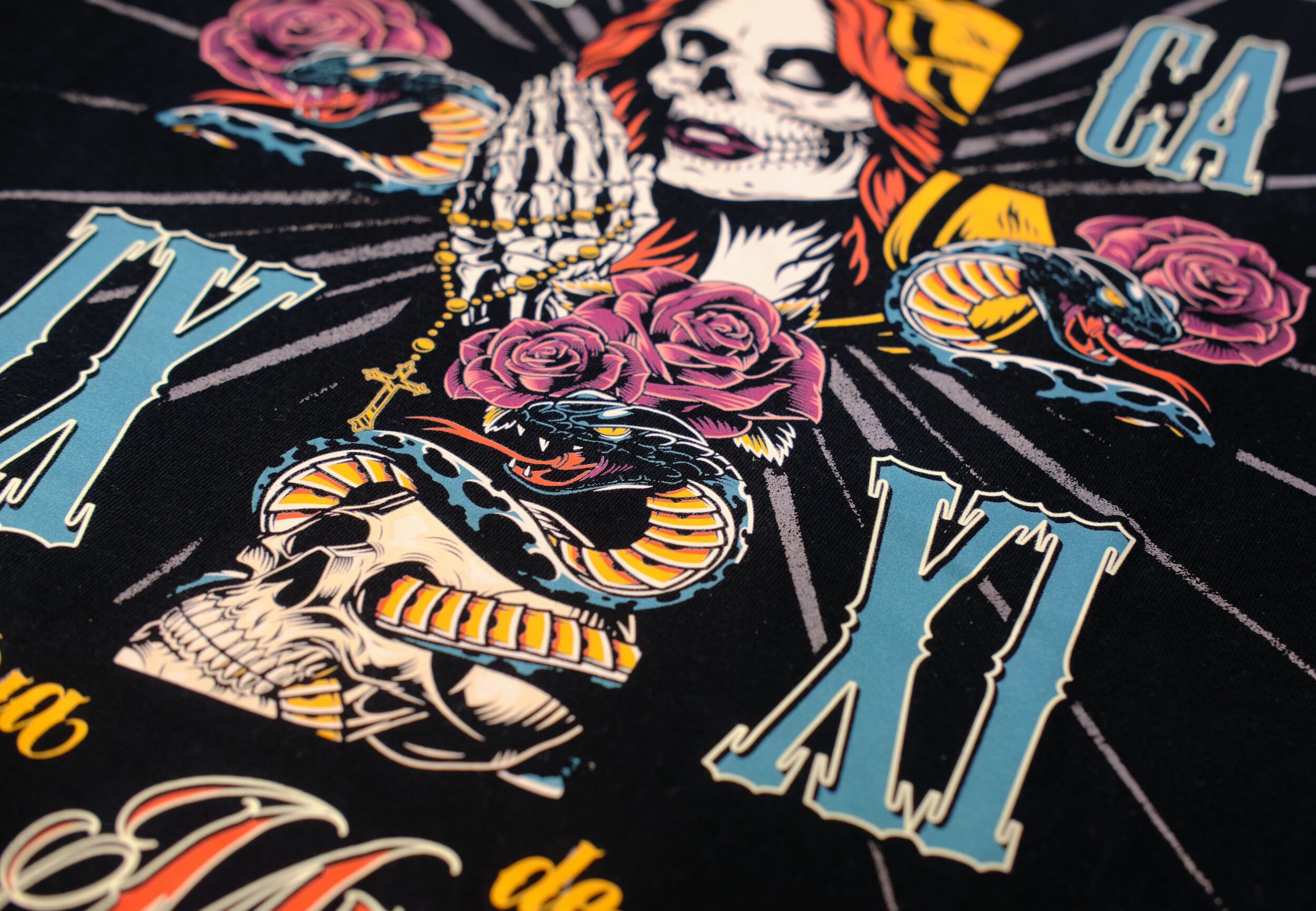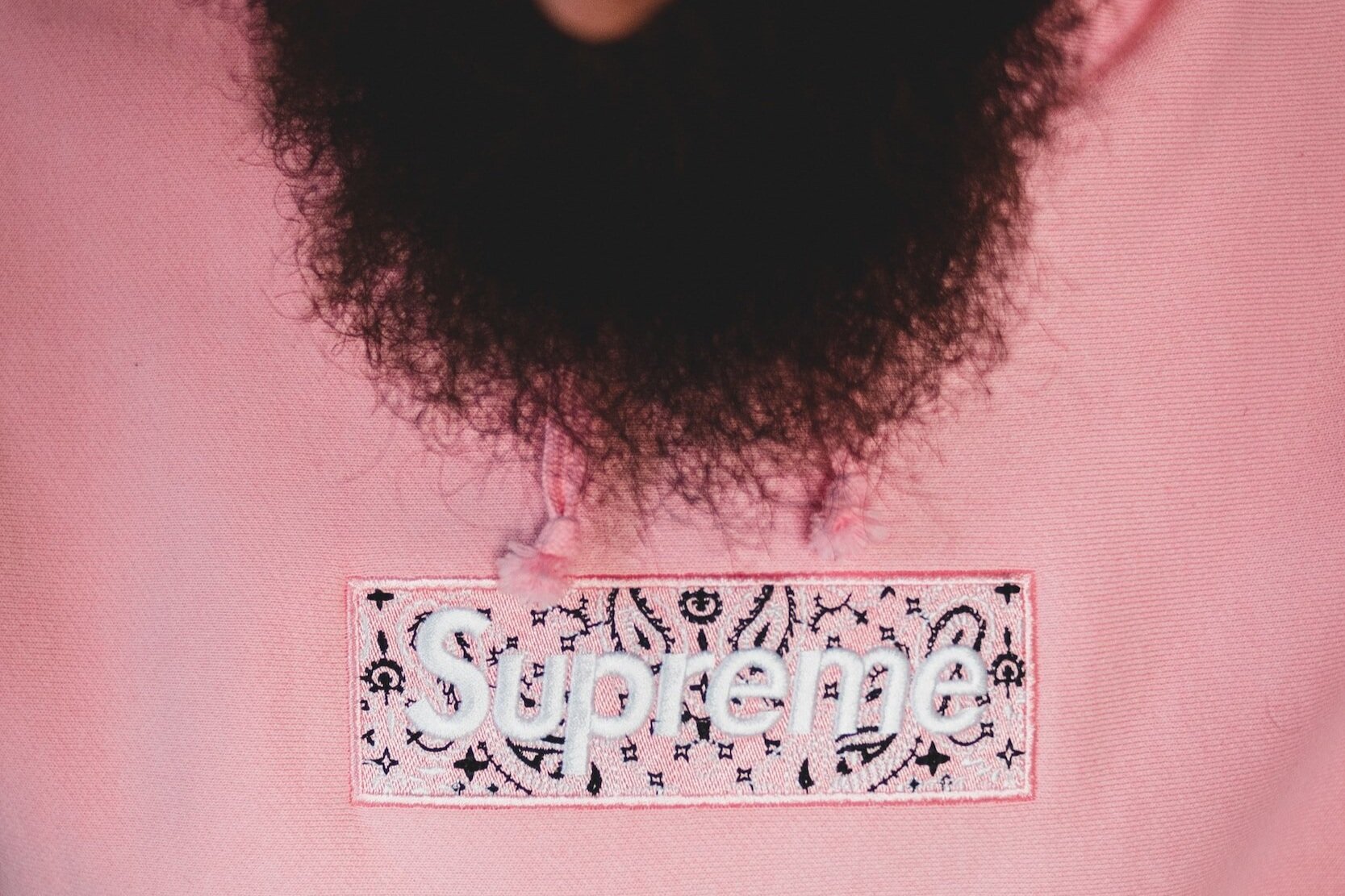On the surface, merchandise seems simple. You got an image, we put it on clothing, the end. But of course, nothing can ever be that simple.
Many factors influence what is possible when it comes to bringing your idea to life. The main considerations are:
- The number of colors in a design.
- Your budget.
- The size and shape of the garment that’s being decorated.
- The fabric the garment is made of.
Depending on your answers to the above questions, you might use DTG, heat-press, screen-printing, or embroidery. Let’s break down each one.
DTG (Direct-to-Garment):
DTG is a digital printing method that allows designs to bdirectly printed onto clothing using specialized inkjet printers. It is similar to printing on paper, but instead of paper, the ink is applied directly onto the fabric. DTG printers are designed to handle various fabric types, including cotton, polyester, and blends.
Here’s how the DTG process works:
- The design is created or loaded onto a computer.
- The fabric is placed flat on the DTG printer’s printing platen.
- The printer applies water-based or pigment inks directly onto the fabric according to the design.
- The inks are then cured or fixed onto the fabric using a heat press or a separate curing process.
Advantages of DTG:
- Detailed and intricate designs can be reproduced accurately (especially useful in creating designs with 6+ colors).
- It is suitable for small print runs and one-off custom designs.
- Allows for full-color prints with gradients and shading.
- Eco-friendly, as DTG uses water-based inks.

Heat Press:
A heat press is a chine used to transfer designs or graphics onto clothing using heat and pressure. It involves pre-printing the design onto a special transfer paper or vinyl and then applying it to the fabric using the heat press.
Here’s how the heat press process works:
- The design is printed onto transfer paper or vinyl using inkjet printers or cutting machines.
- The fabric is placed flat on the heat press’s lower plate.
- The printed transfer paper or vinyl is placed on the fabric with the design facing down.
- The upper platen of the heat press is lowered onto the fabric, applying heat and pressure.
- The heat and pressure activate the adhesive on the transfer paper or vinyl, causing the design to adhere to the fabric.
Advantages of Heat Press:
- Can be used for a variety of materials, including fabrics, ceramics, and metal.
- Good for producing designs in bulk or large quantities.
- Works well for simple designs and solid colors.
- Offers a smooth and durable finish when done correctly.

Screen Printing:
Also known as silk-screening, screen-printing might be the most popular method for decorating apparel.
Advantages of Screen Printing:
- Suitable for printing on various materials, including fabrics, paper, plastic, and more.
- Ideal for producing vibrant and long-lasting prints.
- Cost-effective for large print runs, making it popular for commercial production.
- Allows for the use of specialty inks like metallic and glow-in-the-dark.
Here’s how screen printing works:
- Preparing the Design:
- Your design is created or digitized on a computer, resulting in a stencil-like image for each color in your design.
- The screen’s mesh is coated with a light-sensitive emulsion. The stencil is “burned” into the emulsion on the screen.
- Creating the Stencil:
- Each screen represents a single color in the design.
- To create the stencil, the design is printed onto a transparent film or vellum, which is placed on top of the emulsion-coated screen.
- The screen is exposed to bright light, and the emulsion hardens in the areas that are not blocked by the design on the film.
- The garment to be printed is laid flat on a printing platen or a conveyor belt.
- Printing the Design:
- Ink is smeared on the top end of the screen.
- The squeegee is pulled across the screen to transfer the ink, pushing it through the open areas of the stencil.
- Each screen is used for one color, and multiple screens are used in succession to layer the colors, creating the final design.
- Curing the Ink:
- After the printing is complete, the fabric with the freshly applied ink needs to be dried and cured.
- Finally, the garments are passed through a conveyor dryer. The heat cures the ink and ensures it adheres permanently to the fabric.
Embroidery:
Embroidery is a method where designs are stitched directly onto a garment. Embroidery is a traditional and widely appreciated technique that adds texture, depth, and a premium look to garments and patches.
Here’s how embroidery works:
- Your design is digitized to create a DST or PES file. A DST or PES file contains careful instructions for the embroidery machine: setting parameters for stitch types, stitch directions, thread colors, and other details.
- Next the embroidery machine is loaded with the digitized design file and the garment to be embroidered.
- The embroidery machine begins stitching the design according to the instructions in the digitized file. Using various types of stitches, such as satin stitches, running stitches, fill stitches, and more, the machine slowly “builds” the design onto the garment. If a color change is called for the machine changes thread colors automatically based on your design file’s instructions.
- Once the design is complete, any loose threads are trimmed, and any necessary touch-ups or quality checks are performed.
Advantages of Embroidery:
- Creates a professional and sophisticated look, especially on garments like polos, dress shirts, caps, and jackets.
- Provides a textured, raised effect, adding depth to the design.
- Durable and long-lasting, as the embroidered designs are securely stitched onto the fabric.
- Suitable for a wide range of fabric types, including cotton, denim, wool, and more.

We hope is overview gave you a clear understanding of the basic criteria necessary to consider when producing new wearable. If you have a design you’d like to discuss with us, reach out today and we can guide you on the best decoration method.

